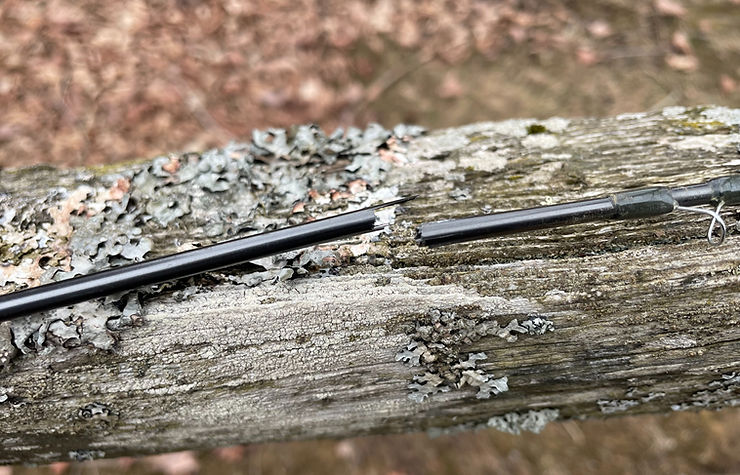The Broken Fly Rod Blues…and How to Fix Them

Broken fly rods are a fact of life, and sooner or later, everyone gets to enjoy the experience of having one of their prized possessions journey to the other side. It doesn’t matter how much you paid for the rod, either. Over 30 years of fly fishing, I’ve owned and used a number of fly rods, everything from St. Croix to Quarrow to G. Loomis to Orvis to TFO (Temple Fork Outfitters), and I can tell you that no brand is invincible, no model immune.
This year, on consecutive outings, I broke my two favorite fly rods, an Orvis Clearwater and a TFO Drift Rod. The Orvis may have been my fault. I’d caught a dozen or so trout before snagging a twig on the stream bottom, and instead of freeing the snag by pulling on the line, I decided to try and hoist the small branch up out of the water and onto the bank. Bad idea. A clean break about two-thirds of the way down the top section. Fortunately, I had my TFO in the truck that evening, and caught another 25 or so trout before dark, which helped ease the pain of the broken rod.
A couple days later, I met a buddy on a nearby Class A stream. With my TFO in hand, I felt confident we were in for a good day. Well, ten minutes into the outing, I walked up on a pool, unhitched my fly from the guide and pulled on it to clear the leader from the rod tip, something I’d done literally thousands of times in the past. This time, there was that knuckle cracking sound again, and the broken tip of the TFO slid down the length of the leader all the way to my hand.
On this trip, I had no spare rod in the truck, so I was relegated to observer, which I really didn’t mind. We had a good day and my friend caught several very nice trout, including a 17-inch wild brown.
Repairs and Replacements
Nowadays, it feels like broken rods are no big deal. Companies have made it easier than ever to get back on the water in a reasonable amount of time. Standardization of parts has made a huge difference. Whereas you used to have to send in the whole rod for repair, many companies now have replacement sections in stock and will send just what you need. That’s a huge convenience and time saver, not to mention it’s usually cheaper than shipping the rod.
Fortunately, Orvis and TFO are both companies that offer replacement parts. I was able to order the tip sections for both rods from their respective companies for $60.00 each.
I’ve always been a fan of Orvis’s customer service, and their 5-day guarantee is the perfect example why. Basically, their goal is to get you back on the water within 5 days of ordering the replacement section. Sure enough, I ordered the replacement on Sunday, March 26th and had it in hand and was fishing with the Clearwater again the evening of Thursday, March 30th.
While I’ll never knock TFO for the quality of their products, their service was slower. I ordered the replacements section for the Drift Rod within minutes of placing the order with Orvis on the 26th, and the section did not arrive until two weeks later, on April 8th. Granted, this is still much better than the 4-6 week turnaround time of the past, when you had to send in the whole rod for repair.

(Photo: The replacement tip from Orvis had me back on the water in no time!)
How Rods Break
When I got home after breaking the TFO, I laid the broken tips of both rods on my desk. Each of them had snapped in approximately the same spot, two-thirds of the way down from the tip. The Orvis showed some slight splintering whereas the TFO was a crisp break. When I called Orvis and spoke to one of their service guys, he said that was a common location for the rod to break because the fly, split shot, or even the strike indicator can nick the graphite during the false cast, and many people don’t even realize they caused any damage until hours or days or weeks later when the rod simply snaps.
I also asked him if fishing in extreme cold might somehow made the graphite brittle. The Clearwater as well as the TFO broke in temperatures in the 20s. The service technician said extreme cold should not have an impact on the graphite.
Of course, it occurred to me that the common denominator in both broken rods was me! And in all fairness, I beat up my gear more than most fishermen. They’re always in my truck, in or out of their protective cases, in extreme cold and extreme heat.
Sometimes, it amazes me that I don’t break rods more often. However, I do feel like my habits make me a good test monkey for products. If they can withstand my negligence, I’m pretty sure they will last a lifetime with someone else.
Do Warranties Matter?
I often read articles about the warranties of certain rod manufacturers. Companies are all over the map of what they’ll cover or not cover, and you’re always subject to their discretion of whether they deem the damage a product of user error or manufacturer defect. I’d like to see them get away from the “blame game” and adopt the no-questions-asked policies that Orvis and TFO have. Also, I’m not a fan of the non-transferrable clause stating that the warranty is only available to the original owner of the rod. This reduces the resale value of the rod, if ever you should choose to part ways with it. The warranty should follow the rod even if it changes hands, or have a time limit such as Orvis’s 25-year guarantee.
If you’d like to read a company-by-company breakdown of rod warranties, here’s a pretty good article I found on sippingmayflies.com. It was posted in 2021 and several companies listed have since changed policies, but it gives you a good idea of what to expect if your favorite rod should ever bite the dust, so to speak.
Personally, I don’t make my rod-buying decisions based on manufacturer warranty, mainly because once you get above a certain price point (usually a couple hundred dollars), the warranties are pretty similar from one company to another. You can purchase replacement sections or get a rod repaired for a fraction of the purchase price of a new rod, and that’s good enough for me.
Three Takeaways
Three final thoughts concerning broken rods and repairs. First, it’s a reminder to invest in quality. When you buy quality products from quality companies, you can rest assured that you’ll be back on the water with limited hassle in a reasonable amount of time.
Second, broken rods happen, and no matter how much it costs, no brand or model is invincible.
And third, you can never have enough fly rods! Having a spare fly rod in the vehicle at all times will ensure that a broken tip won’t ruin your day. But more than that, it’s important to have a back up for your back up. And a back up for the back up of your back up, and…
Well, you get the picture.
Sign up for the Dark Skies Fly Fishing e-newsletter
It's free, delivered to your inbox approximately three times each month.
Sign Up Now

Good info and worth considering when buying a new rod. I have had great experiences with Loomis, Orvis, and St Croix repairs. I seem to be the king of breaking rods so I have a lot of experience with replacement. In one case Orvis automatically upgraded me to a new better model. St Croix actually called me and asked if I would like their higher end model as a replacement for a small price increase over the replacement. Even when the rod is old or did not have a warrenty, if you love the rod it is good to enquire with the manufacturer. I broke a 3-piece Winston IM6 around 2006 that was sold without a warrenty. Just this year I enquired about a repair and was able to pat $175 to get a really great rod back in service. Similarly with an older Loomis, that I actually lost the tip section, when I called customer service they were able to find some spare tip sections for this out of warrenty rod. In that case I purchased two new tip sections for $50 a piece.
Hey Ralph,
I’m sorry that you broke two of your favorite rods in the span of a few days. Nevertheless, you are accurate that this is an experience that all fly fishermen experience at some time in their angling ventures. The good news is that both companies honored their warranties and got you back on the water within two weeks.
I also warrantied a TFO fly rod years ago when I left it on top of my car in the tube and drove away. It finally rattled off on the freeway miles away, was run over by several vehicles and skipped off of an overpass onto the concrete below. This is all true and not embellishment. As you might imagine, the rod was shattered. I contacted TFO and was genuine with what had happened. They replaced the rod asking no questions.
I am an Orvis “guy!” I prefer their fishing rods over all other brands. I have yet to break an Orvis rod. Knock on wood immediately! However, Orvis has replaced two pairs of wading boots that became delaminated and repaired an older model CFO reel that I had bent the spindle. Again, no questions asked and they simply backed their products for me.
Additionally, I am certain that your buddy was very thankful that you remained with him to observe his fishing. As a matter of fact, I heard that brown that was pushing 18″ is the best Pennsylvania wild trout of his life and you put him on that fish. Next time you see him, remind him that he owes you big time!
Sincerely,
Justin
Hi I am looking to see if a section off my fly rod can be repaired or even shortened to slot into top section
That’s a good question. If it’s a high-end rod, I’d contact the manufacturer and see if there’s any type of warranty or if you can buy a replacement section before doing anything. If that doesn’t pan out, try a rod builder and maybe they can make a piece for it using another blank. Hope this helps! Ralph
I had pretty good luck using a section of broken spinning rod as an internal sleeve when fixing my Echo Euro rod this past week. I’ll readily admit that I’m both a little bit handy, and a LOT of a cheapskate, so take that into account if you decide to follow suit.
Here’s my method:
If you happen to have an old, preferably broken, rod in the basement or garage, you can cut out a 2.5 to 3″ section to use as kind of an internal ferrule to hold the busted pieces together. Will it change the flex pattern for that section of the rod? Sure. Will you notice it on the water? Probably not. The key is to make sure that the taper of the ‘donor’ rod matches perfectly with the internal taper of the one you’re trying to fix. Then sand off the outer coating, and cut a section that will extend about halfway in either direction from the break. You’ll want to make sure that there isn’t any interference with your new sleeve and any existing joints between rod sections. Do a quick dry fit by sliding the section into the broken rod and lining things up. Then wipe down the surface with rubbing alcohol and use a cotton swab to do the same with the internal section of the rod. Then mix up some high quality epoxy and coat both the inside of the rod and the outside of the sleeve. Let the epoxy cure for at least 24 hours and you should be good to go!